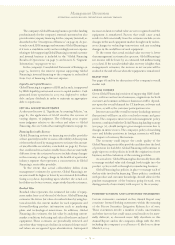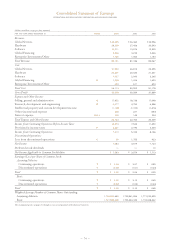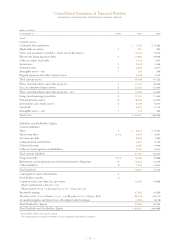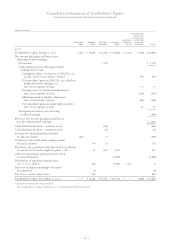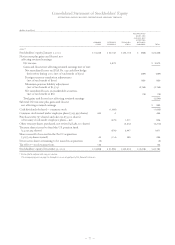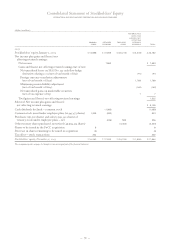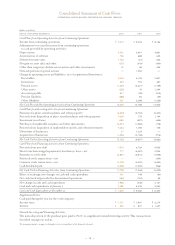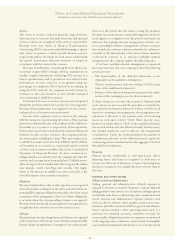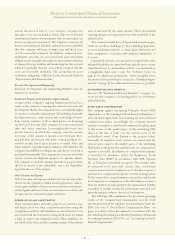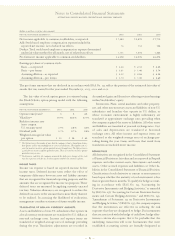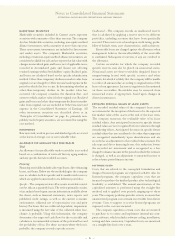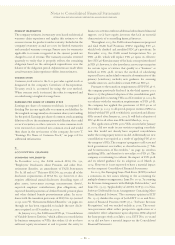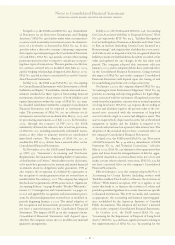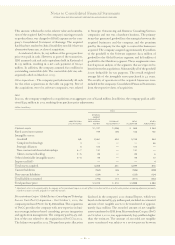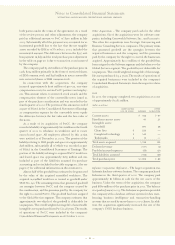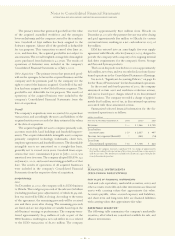IBM 2003 Annual Report Download - page 84
Download and view the complete annual report
Please find page 84 of the 2003 IBM annual report below. You can navigate through the pages in the report by either clicking on the pages listed below, or by using the keyword search tool below to find specific information within the annual report.
actions discussed in note S, “2002 Actions,” on pages 105
through 107 are also included in SG&A. The cost of internal
environmental protection programs that are preventive in
nature are expensed as incurred. The company accrues for all
known environmental liabilities when it becomes probable
that the company will incur cleanup costs and those costs
can be reasonably estimated. In addition, estimated envi-
ronmental costs that are associated with asset retirement
obligations (for example, the required removal and restoration
of chemical storage facilities and monitoring) are also accrued
when it is probable that the costs will be incurred and the
costs are reasonably estimable. The accounting for asset
retirement obligations (AROs) is further discussed below in
“Depreciation and Amortization.”
Research, Development and Engineering
Research, development and engineering (RD&E) costs are
expensed as incurred.
Intellectual Property and Custom Development Income
As part of the company’s ongoing business model and as a
result of the company’s ongoing investment in research and
development (R&D), the company licenses and sells the rights
to certain of its intellectual property (IP) including internally
developed patents, trade secrets and technological know-
how. Certain transfers of IP to third parties are licensing/
royalty-based fees and other transfers are transaction-based
sales and other transfers. Licensing/royalty-based fees
involve transfers in which the company earns the income
over time, or the amount of income is not fixed and deter-
minable until the licensee sells future related products (i.e.,
variable royalty, based upon licensee’s revenue). Sales and
other transfers typically include transfers of IP whereby the
company has fulfilled its obligations and the fee received is
fixed and determinable. The company also earns income from
certain custom development projects for specific clients.
The company records the income from these projects when
the fee is earned, is not refundable, and is not dependent
upon the success of the project.
Other (Income) and Expense
Other (income) and expense includes interest income (other
than from the company’s Global Financing business transac-
tions), gains and losses from securities and other investments,
realized gains and losses from certain real estate activity, and
foreign currency transaction gains and losses.
DEPRECIATION AND AMORTIZATION
Plant, rental machines and other property are carried at cost
and depreciated over their estimated useful lives using the
straight-line method. ARO liabilities are the estimated costs
associated with the retirement of long-lived assets for which
a legal or contractual obligation exists. These liabilities are
recorded at fair value and the carrying amount of the related
asset is increased by the same amount. These incremental
carrying amounts are depreciated over the useful life of the
related assets.
The estimated useful lives of depreciable properties gen-
erally are as follows: buildings, 50 years; building equipment,
20 years; land improvements, 20 years; plant, laboratory and
office equipment, 2 to 15 years; and computer equipment, 1.5
to 5 years.
Capitalized software costs incurred or acquired after tech-
nological feasibility are amortized over periods up to 3 years.
Capitalized costs for internal-use software are amortized on
a straight-line basis over 2 years. See “Software Costs” on
page 85 for additional information. Other intangible assets
are amortized for periods up to 7 years. See “Standards Imple-
mented” on page 88 for additional information on goodwill.
RETIREMENT-RELATED BENEFITS
See note W, “Retirement-Related Benefits,” on pages 110
to 117 for the company’s accounting policy for retirement-
related benefits.
STOCK-BASED COMPENSATION
The company applies Accounting Principles Board (APB)
Opinion No. 25, “Accounting for Stock Issued to Employees,”
and related Interpretations in accounting for its stock-based
compensation plans. Accordingly, the company records
expense for employee stock-based compensation plans equal
to the excess of the market price of the underlying IBM
shares at the date of grant over the exercise price of the
stock-related award, if any (known as the intrinsic value).
Generally, all employee stock options are issued with the
exercise price equal to the market price of the underlying
IBM shares at the grant date and therefore, no compensation
expense is recorded. In addition, no compensation expense
is recorded for purchases under the Employees Stock
Purchase Plan (ESPP) in accordance with APB Opinion
No. 25. This plan is described on page 110. The intrinsic value
of restricted stock units and certain other stock-based
compensation issued to employees as of the date of grant is
amortized to compensation expense over the vesting period.
To the extent there are performance criteria that could result
in an employee receiving more or less (including zero) shares
than the number of units granted, the unamortized liability
is marked to market during the performance period based
upon the intrinsic value at the end of each quarter.
The following table summarizes the pro forma operating
results of the company had compensation cost for stock
options granted and for employee stock purchases under the
ESPP (see note V, “Stock-Based Compensation Plans,” on
pages 109 and 110) been determined in accordance with the
fair value-based method prescribed by Statement of Financial
Accounting Standards (SFAS) No. 123, “Accounting for Stock-
Based Compensation.”
Notes to Consolidated Financial Statements
INTERNATIONAL BUSINESS MACHINES CORPORATION AND SUBSIDIARY COMPANIES
82



